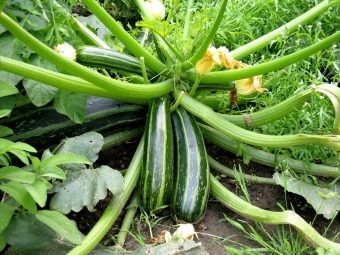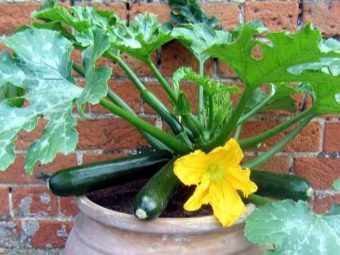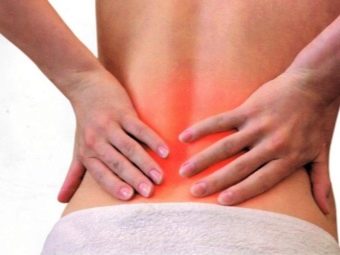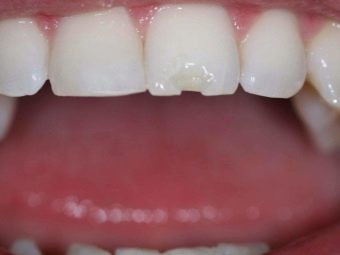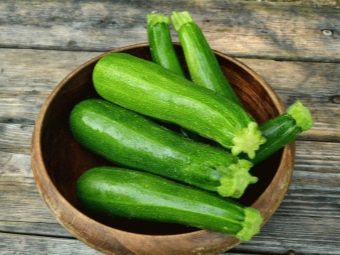What is zucchini, how do they differ from zucchini? Properties and cultivation
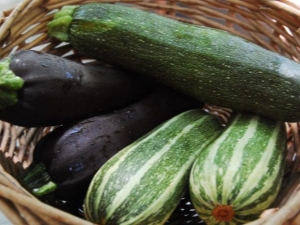
Very often lately we hear about such a vegetable as zucchini.Today we will understand what kind of vegetable it is possible to grow it at home, what kind of care it needs and how it is used in cooking.
What it is?
Zucchini - a product popular in the West. Belongs to squash varieties, a variety of pumpkin. In appearance oblong shape and green. One of the obvious advantages that is worth noting is that the vegetable ripens within 3-7 days after flowering and is ready for use. Per 100 grams of this product accounts for only 16 kcal.
In taste, the best will be young zucchini. Due to the fact that they are quickly absorbed, they are even added to the menu for children and people who stick to a diet, recover from an illness and go to recovery. also suitable for those who have any problems with digestion. And, of course, as mentioned above, zucchini is often used by people who adhere to diets and want to lose weight, and all because the product is easily digested and low-calorie. The optimal size of the fruit reaches 15 cm, it can be used both raw and cooked for any favorite recipe: fry, stew, use in salads. Vegetable goes well with a variety of herbs and seasonings.
Found a vegetable is also used in cosmetics. Its seeds are added to creams to regulate the functioning of the sebaceous glands. If you wish, you can grow a plant right in your own home, just remember that it loves warmth and even a positive temperature of up to +2 degrees is considered frosted for a plant and may result from death. The main recommendations include storage at room temperature and washing the product only before meals.
What is different from zucchini?
Zucchini is a vegetable that is not easily confused with a zucchini, because apparently they are not very similar. Taste, storage conditions, care and the principles of their growth are also completely different.
Find the difference between these two vegetables can be on the following grounds:
- Zucchini ripen much faster than zucchini. Already for 4-7 days you can collect ripe fruit. During this period, zucchini has a thin peel and excellent taste.
- Even a novice in color can distinguish two vegetables. Zucchini has a dark green color, there are also many variations of it. In squash, on the contrary, the color is rarely green, more often there are variations of yellow and white colors.
Noticeable difference can be seen on the basis of the size of the vegetable. Zucchini grow small and do not exceed 25 cm in length, which is not the case with zucchini. You can grow a large zucchini, but at the same time you lose other ovaries that appear on the bush.
As for seeds, in comparison with zucchini zucchini seeds it will be difficult to make out, since they are so small that it is difficult to see them in the pulp.
As mentioned earlier, zucchini ripen faster compared to zucchini, but caring for them should be scrupulous, because the vegetable requires a lot of heat and sunlight.
Zucchini grows in the form of bushes and does not take up much space in your garden, and the zucchini, in turn, produces shoots and they diverge in different directions.
As for storage, zucchini can be stored at home at room temperature for only 4-5 days, and zucchini can withstand rather long storage.
To taste, zucchini also wins, as it has a delicate, slightly sweet taste and a decent aroma. And the flesh of zucchini is rather coarse and therefore it is better to eat it only in processed form.
Having understood what kind of vegetable disappeared under the interesting name of zucchini, it’s worth talking about which varieties are the most popular today.
Popular varieties
There are zucchini varieties such as Tsukesha, Diamant, Zheltoplodny, Zebra, Nephrite, Skoruushka, Pharaoh, Banana, Rhonda, Zolotinka, and Black Beauty , "Negro", "Tiger". About the most popular talk further.
Let's start with the sort that got its name because of the color: skin "Yellowberry" vegetable when ripe has a dark yellow color.The variety has a high yield and does not require special care. You can get a good harvest after 40 days after planting the seeds, of course, observing comfortable conditions for its growth. Inside the fruit is a dense structure, juicy and has a light yellow color. Keeps a worthy presentation when moving and long storage. To plant it in the ground gardeners advise in late May, early June. Eating a fetus is worth it, as people who suffer from kidney disease can make a disease such as hyperkalemia (elevated levels of potassium in the blood) that can be life-threatening if it is misused.
If you do not have any health problems and you just want to lose weight or go on a proper diet, then use zucchini as a basis for dishes, and you will get the most essential trace elements for your body.
The next sort of zucchini to talk about is "Negro". Like the previous variety, it matures fairly quickly - over the entire 43 days. Bushes look compact, and the color of zucchini becomes dark green in color, because of which the variety got its name. The flesh inside is also dense, quite tender and light in taste. Vegetable is suitable for transportation, despite the fact that it has a fairly soft outer crust.
As for this type of bush varieties, it is a great option for growing zucchini in the open field. Despite the fact that the bush looks compact, its leaves grow quite wide. Therefore, planting such species close is not recommended, their roots do not go deep into the ground, but try to take a place under the foliage. If you leave not enough space, the zucchini will start fighting for “a place under the sun”, and they will not only lack nutrients, the vegetable will just slowly begin to die.
Benefit
With regard to the composition of the vegetable, then the zucchini and zucchini are almost identical in content of nutrients, only the first digested much easier and faster. Zucchini consists of fats, carbohydrates, proteins, as well as acids, albeit in small quantities. Among the mineral components in the composition you can find a lot of calcium, as well as sodium, magnesium and iron.
After eating such a vegetable, you can notice how your digestion has improved, making your metabolism faster, which will help you get rid of extra pounds faster. Another secret zucchini is that the smaller it is, the less time you spend on its preparation. Vegetable is good in any form and with any side dish that you prefer. Cooking it for a long time is not worth it, as it can just boil soft and become tasteless.
Calorie and nutritional value
We now turn to a question that worries many of the fair sex - the calorie and nutritional value of this product. To a greater extent, the product consists of water - by 92.7%. Protein per 100 g of the product 2.7 g, fiber and carbohydrates - 1.1-2 g.
As for vitamins, here you can find vitamins A, B1, B2, B5 and, as mentioned earlier, magnesium, calcium, iron and potassium.
If you eat 100 grams of zucchini, the body will receive only 21 kcal.
Harm
Like any product, zucchini has not only good qualities, but bad ones are also present.
The product can negatively affect those people who have diseases associated with the gall bladder or kidneys. The composition of zucchini includes a large amount of oxalate, it can cause the development of urolithiasis. If you know that calcium withdrawal is disturbed in you, you should also give up this vegetable. In addition, the teeth may suffer as well, since zucchini contains seeds that are harmful to them, so tooth enamel may be threatened.
Is it possible to eat raw?
Zucchini belong to the genus Kabachkov, but differ from them in that they can be safely eaten raw.However, you should be careful, because not all types of this vegetable are beneficial to our body. Zucchini refers to a species that is able to protect itself from environmental influences through the release of toxic substances to the surface of its skin. For example, cucurbitacin can cause complex food poisoning, which can even be fatal. Therefore, if you grow zucchini in your garden, do not plant them next to other vegetable and berry crops, as the poison can spread to them.
It is extremely difficult to determine whether a vegetable is poisonous or not, but as regards its taste, it will be so bitter in the affected fruit that you cannot even swallow it, and, sadly enough, this dose is already enough for lesions of the body. But, fortunately, it is almost impossible to get poisoned from the zucchini grown on its own plot or purchased in the store, the danger is only those products that are on the bush for a long time and simply overripe. It is in them can produce toxic substances.
Growing up
Many people deny themselves the purchase of certain fruits or vegetables on the market. After all, no one knows how to feed and protect these plants at the stage of their maturation. It’s much safer to grow food on your own plot with your own hands. If you are going to start growing such a vegetable as zucchini, then you should remember that there are two ways to plant it - seedling and seed.
So, the first way - rassadny. Zucchini is a heat-loving plant, so if you live in a fairly cool climate, it is better to refrain from planting seedlings in open ground. April, more precisely, the end of the month will be a favorable period for planting seeds, but the seedlings should be planted in the ground after 25-30 days.
This option is suitable for those who have their own land and the ability to grow more than one bush. If you want to grow zucchini on the windowsill, then there is a slightly different principle. Before planting, it is necessary to sort out all the seeds, throw away the empty ones and dry them well for planting. This can be done either on the battery, wrapping the seeds in paper, or in the oven for 4 hours at a temperature of 50-60 degrees. After such a drying is worth doing a number of procedures.
The first thing you need to wash the seeds. This can be done with a very weak solution of potassium permanganate. To increase the germination and yield will help boric acid in a concentration of 0.002%. If you do not want to engage in the preparation of such a solution, there are special stimulants for sale that provoke rapid growth of the plant.
Further, a period of so-called hardening begins at the seeds. To do this, place the seeds in a damp cloth and leave at medium room temperature for 6 hours, after this time, move the package in the refrigerator for a day on the lower shelf.
While the planting material is hardening, it is necessary to prepare the soil. To do this, mix the turf soil, humus, coarse sand and peat in equal proportions. If you do not have such components, you can buy the soil for seedlings in the store, but you still need to add sand to it.
The capacity in which you grow seeds can be completely different, ranging from a plastic cup and ending with special tablets, which must first be soaked in water. Now consider the principle of planting seeds in the soil step by step.
First of all, gather the soil in the containers prepared for the seedlings, make a small depression for the seeds and pour the ground well. Spread 1-2 seeds in each well, after which you need to cover the container with a plastic bag and put it in sunlight. The approximate temperature should vary in the range of 20-22 degrees Celsius. When the seeds begin to germinate, the bag can be removed.
If you live in a region where weather conditions are difficult or clayey, then it is better to plant zucchini on high beds. So your vegetables can warm up well for quick and comfortable growth. When choosing a plot on which zucchini will grow, it is worthwhile to give preference to the place where cabbage or peas used to grow.
Care
One of the basic rules for growing zucchini, which is worth remembering, is constant monitoring of the soil moisture level. It will be good to bloom a vegetable in the presence of a pollinator - bees or a bumblebee. To attract it, prepare a solution based on honey and spray the next harvest in the morning. To do this, take 1 tsp. honey and stir in 1 glass of water. If you do not do this, then there will be no pollination, which is why the plant will begin to ache, turn yellow and eventually dry out. It happens that there are no insects, for example, when grown on a window sill, then you can pollinate the flowers yourself. To do this, you will need to take the male flower and gently lean it against the female. This action will allow the pollen to move and fertilize the pistil.
When a zucchini grows during the growing season, the bush can grow leaves that will interfere with the airing of the fruit and their further pollination. This happens even despite the fact that the vegetable itself looks quite compact. To get rid of excess greens cut 2-3 sheets. So the plant will begin to grow and develop better. If you suddenly notice that the growing fruits have begun to touch the ground, then place a plank or plywood under them, in which case your harvest will not begin to mold and rot.
As for the collection and storage of the crop itself, in order to enjoy a good and high-quality crop, it must be harvested on time. When the fruits reach a size of 10-15 cm, they can be safely collected; it is at this stage of growth that the fruits are the most delicious. Zucchini peel is so thin that you can safely eat it, the pulp is also very soft. If you harvest in time, you will create an opportunity for new ovaries to emerge and to re-harvest, especially since in the summer you can pick vegetables almost every week.
Fruits collected with a thin peel can be eaten immediately, which cannot be said about zucchini. Their skin is somewhat thicker and they can be stored for a long time. When storing it is necessary to adhere to a temperature from 3 to 10 degrees above zero, humidity not less than 60%, but not more than 70%. Constantly ventilate the room where vegetables are stored. In this case, the fruit is better to cover with a cloth so that the light does not fall on them. When storing zucchini in the refrigerator, they should be put in the bag. In this form, they can be stored for about a month. Best of all, its properties are retained in frozen vegetables. You can pre-cut it as you like, and put it in this form in the freezer.
Use in cooking
As mentioned earlier, it is better to use young fruits and early harvest for food. You can do with them everything your heart desires: bake, fry, boil, just pickle or preserve. An excellent solution would be soup, mashed potatoes, stews, or even smoothies and zucchini jam. You can even cook caviar for the winter. There is squash caviar, the same can be made from zucchini, it will be a good option as a snack. If in your diet there is a rather heavy protein food, then a side dish of zucchini will be an excellent addition to this dinner or lunch. In this case, you can add baked zucchini to the main dish and lightly sprinkle them with cheese on top, which will make them even juicier.
You can also marinate this vegetable. The taste of the dish will be delicious, because the zucchini itself is sweetish, and the marinade can be made sour.
Gourmets will like the dish of zucchini, which will be stuffed with meat with a side dish of rice. The combination is just amazing. In this case, zucchini is cut into thin layers, after which the mince is wrapped in them like a roll.
Mediterranean cuisine is simply impossible to imagine without such a vegetable as zucchini. But before sending the product to the pan, the Italians make a marinade of lime juice and olive oil. The combination of these components helps to feel the full range of flavors of this pickled vegetable.
Zucchini can be eaten raw. To do this, simply salt them, add pepper or sauce to taste. Also, zucchini is often added to summer salads, as it perfectly complements the first summer vegetables - cucumbers, radishes, cherry tomatoes.
If, however, subject the vegetable to heat treatment, it does not require much time. For example, in order to boil zucchini, just one minute is enough. Peel is also a controversial issue. Someone prefers to eat zucchini with her, and someone peels a vegetable before cooking.
Try to cook zucchini in batter using herbs, parmesan cheese and butter. Even on a festive table, a dish of these components will look very dignified and will be an excellent snack for the main festive menu. You can also use a recipe such as zucchini rolls with the addition of soft cheese and herbs. Such an appetizer will not leave guests indifferent.
Excellent product suitable for those who play sports and adheres to the rules of proper nutrition. Indeed, per 100 grams accounts for only 16 kcal. However, those people who suffer from kidney disease, should be careful when using this vegetable, as zucchini for the most part consists of water.
What is the difference between the usual zucchini and zucchini, see the video below.

